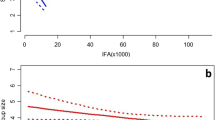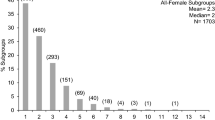Abstract
Many species show fission-fusion group dynamics because it has clear advantages for flexibly exploiting heterogeneous environments. However, the mechanisms by which these dynamics arise are not well known. We used a hierarchical Bayesian model to disentangle the different influences on spider monkey (Ateles geoffroyi) individual fissions and fusions, including the three dimensions of fission-fusion dynamics (subgroup size, dispersion, and composition). Furthermore, we considered the influences of other individuals also leaving or joining a subgroup at the same time. We found that the most important influence on individual fissions and fusions is whether other individuals are also doing the same. Subgroup size and dispersion did not have clear effects on the probability that an individual fissioned or fusioned, while individuals tended to leave subgroups that were biased toward the opposite sex and to join subgroups that were biased toward their own sex. The networks constructed by the inter-individual influences during fissions and fusions were cohesive and did not show assortativity by sex or by degree. Individuals had a similar degree in both networks and each was influenced by a different set of individuals, suggesting a high fluidity in the social networks. We suggest that these networks reflect the way in which information about the environment flows as individuals follow one another during fissions and fusions.








Similar content being viewed by others
References
Asensio N, Korstjens AH, Schaffner CM, Aureli F (2008) Intragroup aggression, fission–fusion dynamics and feeding competition in spider monkeys. Behaviour 145:983–1001
Asensio N, Korstjens AH, Aureli F (2009) Fissioning minimizes ranging costs in spider monkeys: a multiple-level approach. Behav Ecol Sociobiol 63:649–659
Aureli F, Schaffner C, Boesch C, Bearder SK, Call J et al (2008) Fission-fusion dynamics: new research frameworks. Curr Anthropol 49:627–654
Aureli F, Schaffner CM, Asensio N, Lusseau D (2012) What is a subgroup? How socioecological factors influence interindividual distance. Behav Ecol 23:1308–1315
Box GEP, Tiao GC (1973) Bayesian inference in statistical analysis. Addison-Wesley, Boston
Brent LJ, Lehmann J, Ramos-Fernández G (2011) Social network analysis in the study of nonhuman primates: a historical perspective. Am J Primatol 73:720–730
Chapman CA, Chapman LJ, Wrangham R (1995) Ecological constraints on group size: an analysis of spider monkey and chimpanzee subgroups. Behav Ecol Sociobiol 36:59–70
Clark J (2005) Why environmental scientists are becoming Bayesians. Ecol Lett 8:2–14
Clark JS, Gelfand AE (2006) A future for models and data in environmental science. Trends Ecol Evol 21:375–380
Conradt L, Roper TJ (2005) Consensus decision making in animals. Trends Ecol Evol 20:449–456
Couzin ID (2006) Behavioral ecology: social organization in fission–fusion societies. Curr Biol 16:169–171
Couzin ID (2009) Collective cognition in animal groups. Trends Cogn Sci 13:36–43
Couzin ID, Krause J (2003) Self-organization and collective behavior in vertebrates. Adv Stud Behav 32:1–75
Csardi G, Nepusz T (2006) The igraph software package for complex network research. Int J Complex Systems 1695 http://igraph.sf.net
Easley D, Kleinberg J (2010) Networks, crowds, and markets. Cambridge University Press, Cambridge
Fedigan LM, Baxter MJ (1984) Sex differences and social organization in free-ranging spider monkeys (Ateles geoffroyi). Primates 25:279–294
Fischer J, Zinner D (2010) Communicative and cognitive underpinnings of animal group movement. In: Boos M, Kolbe M, Kappeler PM, Ellwart T (eds) Coordination in human and primate groups. Springer, Heidelberg, pp 229–244
Hinde R (1976) Interactions, relationships and social structure. Man 11:1–17
Kerth G (2010a) Group decision-making in fission-fusion societies. Behav Process 84:662–663
Kerth G (2010b) Group decision-making in animal societies. In: Kappeler PM (ed) Animal behaviour: evolution and mechanisms. Springer, Heidelberg, pp 241–266
King AJ, Cowlishaw G (2007) When to use social information: the advantage of large group size in individual decision making. Biol Lett 3:137–139
King AJ, Sueur C, Huchard E, Cowlishaw G (2011) A rule-of-thumb based on social affiliation explains collective movements in desert baboons. Anim Behav 82:1337–1345
Kinzey WG, Cunningham EP (1994) Variability in platyrrhine social organization. Am J Primatol 34:185–198
Lewis JS, Wartzok D, Heithaus MR (2013) Individuals as information sources: could followers benefit from leaders’ knowledge? Behaviour 150:635–657
Lunn DJ, Thomas A, Best N, Spiegelhalter D (2000) WinBUGS—a Bayesian modelling framework: concepts, structure, and extensibility. Stat Comput 10:325–337
Newman MEJ (2002) Assortative mixing in networks. Phys Rev Lett 89:208701
Pinacho-Guendulain B, Ramos-Fernández G (2013) Patrones de asociación y proximidad espacial en monos araña (Ateles geoffroyi yucatanensis). II Congresso Latinoamericano e XV Congresso Brasileiro de Primatologia. Sociedade Brasileira de Primatologia, Recife
R Core development team (2013) R: A language and environment for statistical computing. http://www.R-project.org
Ramos-Fernandez G (2005) Vocal communication in a fission-fusion society: do spider monkeys stay in touch with close associates? Int J Primatol 26:1077–1092
Ramos-Fernandez G, Boyer D, Gomez VP (2006) A complex social structure with fission–fusion properties can emerge from a simple foraging model. Behav Ecol Sociobiol 60:536–549
Ramos-Fernandez G, Boyer D, Aureli F, Vick LG (2009) Association networks in spider monkeys (Ateles geoffroyi). Behav Ecol Sociobiol 63:999–1013
Ramos-Fernández G, Pinacho-Guendulain B, Miranda-Pérez A, Boyer D (2011) No evidence of coordination between different subgroups in the fission-fusion society of spider monkeys (Ateles geoffroyi). Int J Primatol 32:1367–1382
Ramos‐Fernández G, Vick LG, Aureli F, Schaffner CM, Taub DM (2003) Behavioral ecology and conservation status of spider monkeys in the Otoch Ma’ax Yetel Kooh protected area. Neotrop Primates 11:155–158
Shaffer C (2013) GIS analysis of patch use and group cohesiveness of bearded sakis (Chiropotes sagulatus) in the upper essequibo conservation concession, Guyana. Am J Phys Anthropol 150:235–246
Shimooka Y (2005) Sexual differences in ranging of Ateles belzebuth belzebuth at La Macarena, Colombia. Int J Primatol 26:385–406
Slater KY, Schaffner CM, Aureli F (2009) Sex differences in the social behavior of wild spider monkeys (Ateles geoffroyi yucatanensis). Am J Primatol 71:21–29
Smith JE, Kolowski JM, Graham KE, Dawes SE, Holekamp KE (2008) Social and ecological determinants of fission-fusion dynamics in the spotted hyaena. Anim Behav 76:619–636
Spiegelhalter DJ, Best NG, Carlin Bradley P, van der Linde A (2002) Bayesian measures of model complexity and fit. J Roy Stat Soc B 64:583–639
Sueur C, Petit O, Deneubourg JL (2009) Selective mimetism at departure in collective movements of Macaca tonkeana: an experimental and theoretical approach. Anim Behav 78:1087–1095
Sueur C, King AJ, Conradt L, Kerth G, Lusseau D, Mettke-Hofmann C, Schaffner CM, Williams L, Zinner D, Aureli F (2011) Collective decision-making and fission-fusion dynamics: a conceptual framework. Oikos 120:1608–1617
Symington MM (1988a) Food competition and foraging party size in the black spider monkey (Ateles paniscus chamek). Behaviour 105:117–134
Symington MM (1988b) Demography, ranging patterns, and activity budgets of black spider monkeys (Ateles paniscus chamek) in the Manu National Park, Peru. Am J Primatol 15:45–67
Tokuda M, Boubli J, Izar P, Strier K (2012) Social cliques in male northern muriquis Brachyteles hypoxanthus. Curr Zool 58:342–352
Wakefield ML (2013) Social dynamics among females and their influence on social structure in an East African chimpanzee community. Anim Behav 85:1303–1313
Wallace RB (2008) Towing the party line: territoriality, risky boundaries and male group size in spider monkey fission-fusion societies. Am J Primatol 70:271–281
Williams DA (1982) Extra-binomial variation in logistic linear models. J Roy Stat Soc C-App 31:144–148
Wittemyer G, Douglas-Hamilton I, Getz WM (2005) The socioecology of elephants: analysis of the processes creating multitiered social structures. Anim Behav 69:1357–1371
Zachary W (1977) An information flow model for conflict and fission in small groups. J Anthropol Res 33:452–473
Acknowledgments
We would like to thank Braulio Pinacho-Guendulain for field data collection; Eulogio Canul, Macedonio Canul, Augusto Canul, and Juan Canul for valuable assistance in the field; Filippo Aureli, Colleen M. Schaffner, and Laura G. Vick for sharing the management of the long-term project and two anonymous reviewers for their useful comments on a previous version of this manuscript. Funding for fieldwork was provided by CONACYT (grants J51278 and 157656) and Instituto Politécnico Nacional. Data analysis was conducted during a sabbatical stay by GRF at INIBIOMA-CONICET and the Universidad Nacional del Comahue, supported by CONACYT grant 186678. Funding for JMM was provided by CONICET and PICT 20110790.
Ethical standards
The experiments comply with the current laws of Mexico.
Author information
Authors and Affiliations
Corresponding author
Additional information
Communicated by D. P. Croft
Electronic supplementary material
Below is the link to the electronic supplementary material.
Fig. S1
Results for Model I on the posterior probabilities of fission (a) and fusion (b) as a function of subgroup size and the number of individuals outside the subgroup, respectively. These probabilities correspond to the hyper-parameters μ 1 in the case of males and μ 1 + μ f1 in the case of females and their 95 % HPD credible interval. This hyper-parameter corresponds to the effect of subgroup size on the probability of an individual fissioning or fusioning (PDF 19 kb)
Fig. S2
Results of Model I on the posterior probabilities of fission (a) and fusion (b) as a function of the dispersion of the focal subgroup. These probabilities correspond to the hyper-parameters μ 2 in the case of males and μ 2 + μ f2 in the case of females and their 95 % HPD credible interval. These hyper-parameters represent the effect of subgroup dispersion on the probability of an individual fissioning or fusioning (PDF 20 kb)
Fig. S3
Values of parameter β 4ij , which refers to the influence of individual i on j’s fissions (a) or fusions (b) for the 272 pairs of individuals (considering asymmetric influences). Error bars show the 95 % credible intervals. Clearly positive values, for which the 95 % HPD credible interval lied above the horizontal line at 0, included 77 dyads for fissions and 59 for fusions. These pairs are highlighted as dark blue entries in the matrices shown in (c) for fissions and (d) for fusions, against those pairs that had a value of β 4ij that was not clearly above zero (in light blue). The dark blue pairs are those that were linked in the networks in Fig. 8 (PDF 61 kb)
Rights and permissions
About this article
Cite this article
Ramos-Fernández, G., Morales, J.M. Unraveling fission-fusion dynamics: how subgroup properties and dyadic interactions influence individual decisions. Behav Ecol Sociobiol 68, 1225–1235 (2014). https://doi.org/10.1007/s00265-014-1733-8
Received:
Revised:
Accepted:
Published:
Issue Date:
DOI: https://doi.org/10.1007/s00265-014-1733-8




